PROS
- Optical and motorized zoom
- The luminosity
- Operating discretion
- The integrated sound system
- Smart TV functions
- Sharpness
- The fluidity
- Colorimetry
- Dolby Vision support
CONS
- The contrast
- No certified Netflix App
- Only has 2 HDMI Ports
This projector review of the XGIMI Horizon Ultra comes from our friend Greg all the way over in Europe. He's the briliant mind behind MondoProjos.com. You can find the original piece in French here. The review was done on the European version of the XGIMI Horizon Ultra projector, so the specs of the American version may be different. All opinions are solely his. Greg, the floor is yours...
The Horizon series from Chinese manufacturer XGIMI has been expanded with a new projector being added to its lineup. After a Full HD version (XGIMI Horizon) and 4K iteration (XGIMI Horizon Pro), the latest offering arrives in a slightly different guise from that of its predecessors but above all with several innovations: support for Dolby Vision dynamic metadata, the presence of a hybrid LED laser light source which I had already discussed on the blog and finally a motorized optical unit with focus and zoom. At the time of the test publication, the XGIMI Horizon Ultra was officially launched at the brand's stand at the IFA 2023 show, on September 1, 2023. To save you a costly trip to the site, I invite you to reveal exclusively its performance in this new projector review.
Highlights of The XGIMI Horizon Ultra
The Horizon Ultra, which is one of the classic focal length models (thus placed far from the screen), offers a projection ratio of between 1.2:1 -1.5:1.
This new cube shaped device is one of several new lifestyle projectors that includes the Hisense C1, Formovie X5 and JMGO N1 Ultra. These are all-in-one projectors that feature 4K visuals, impressive built-in speakers and a smart media player, all contained in a compact and portable package.
Note that the Horizon Ultra has already been available in a version adapted to the Asian market but the projector that I am testing today is entirely dedicated to the European and North American markets.
The Ultra should be available in mid-September 2023 at a retail price of $1,699.
Projection Technology
The maximum brightness of this projector that we’re reviewing today is able to produce 2300 lumens with color stability and excellent longevity (lifespan of 25,000 hours).
The square and compact format of the XGIMI Horizon Ultra is used to contain a DMD 0.47 chip with 4K emulation by XPR processing (x4).
The newcomer is HDR compatible with HDR10 and HLG sources. Good news for 3D lovers, as it has this option with DLP-Link glasses to purchase at an additional cost.
There is also talk of 95.5% coverage of the DCI-P3 color space and an integrated audio system developed by Harman Kardon, with a power of 12 W x 2 and the possibility of playing tracks in Dolby Atmos and DTS-HD.
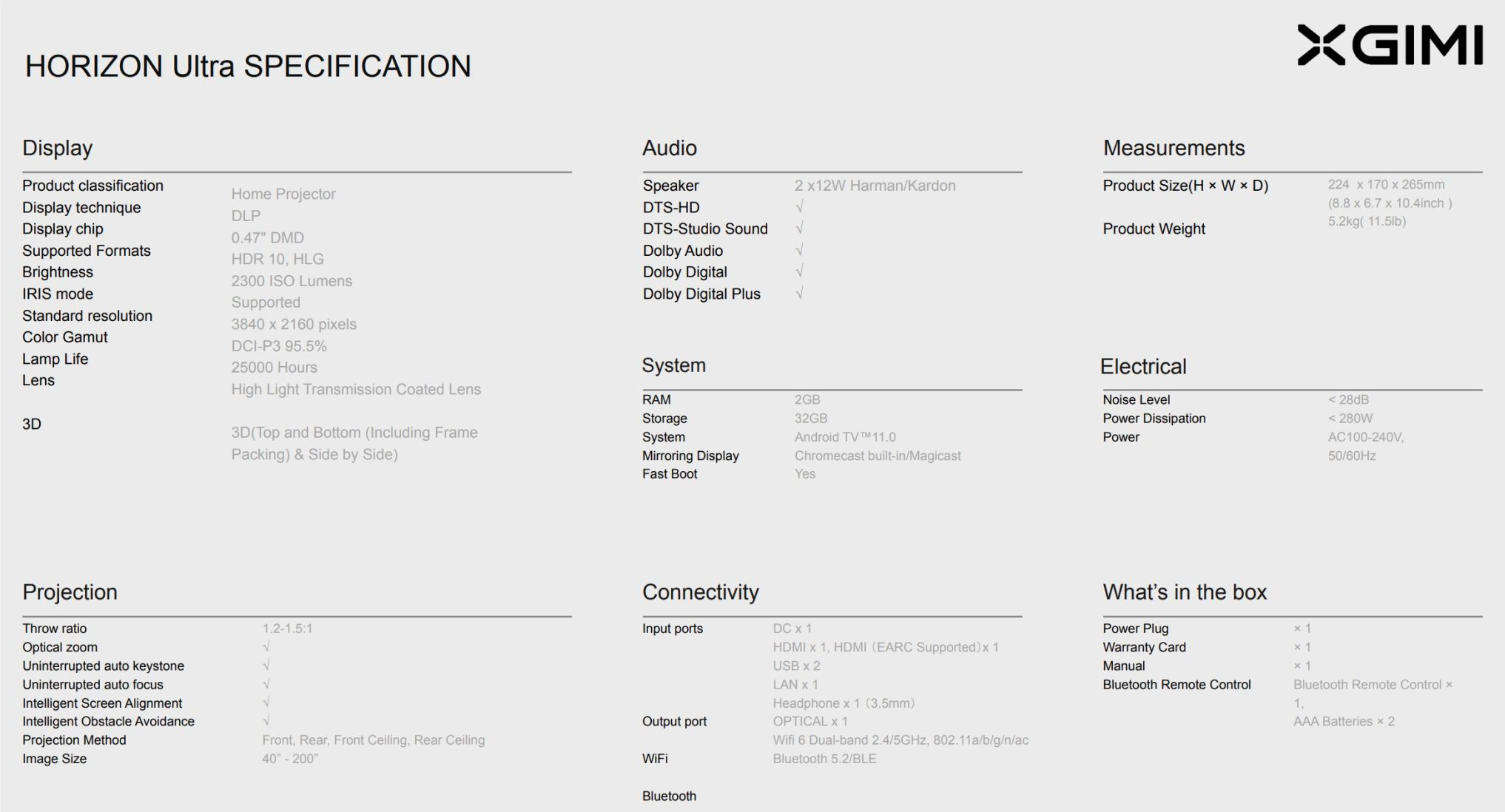 XGIMI HORIZON ULTRA Specifications
XGIMI HORIZON ULTRA Specifications
Smart Projector
Like the other lifestyle projectors, the Horizon Ultra is an all-in-one projector with Smart TV functions based on Android TV 11 with 2 GB of RAM and 32 GB of internal memory. As on all Android TV products, the Google Assistant and Chromecast functions can be used.
Connectivity
Connectivity includes two HDMI 2.0 inputs including 1 eArc, 2 USB-A 2.0 sockets, an optical digital output, Dual-Band Wi-Fi and Bluetooth 5.2 as well as an Ethernet port.
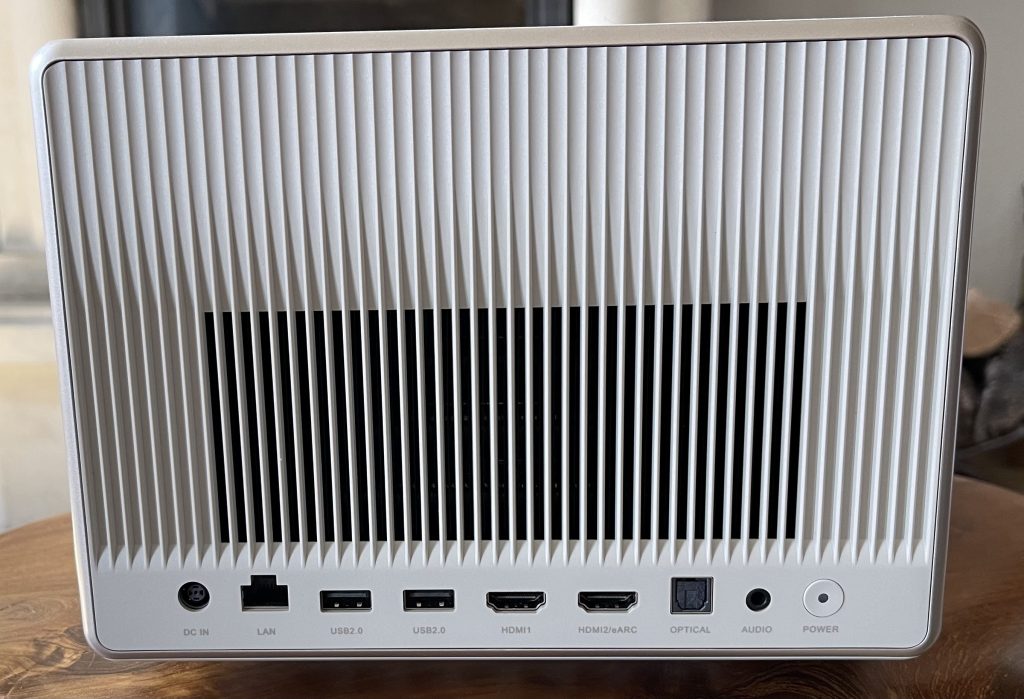 Rear XGIMI Horizon Ultra
Rear XGIMI Horizon Ultra
Focus On The Dual Laser LED Light Source
Previously, projectors relied on one or another light source, each having its advantages and disadvantages. The idea of ??combining the two in this new Dual Light system is to use the strengths of one to counter the weaknesses of the other, in order to obtain a new display technology capable of offering high brightness, a wide gamut and high color accuracy without visual defects.
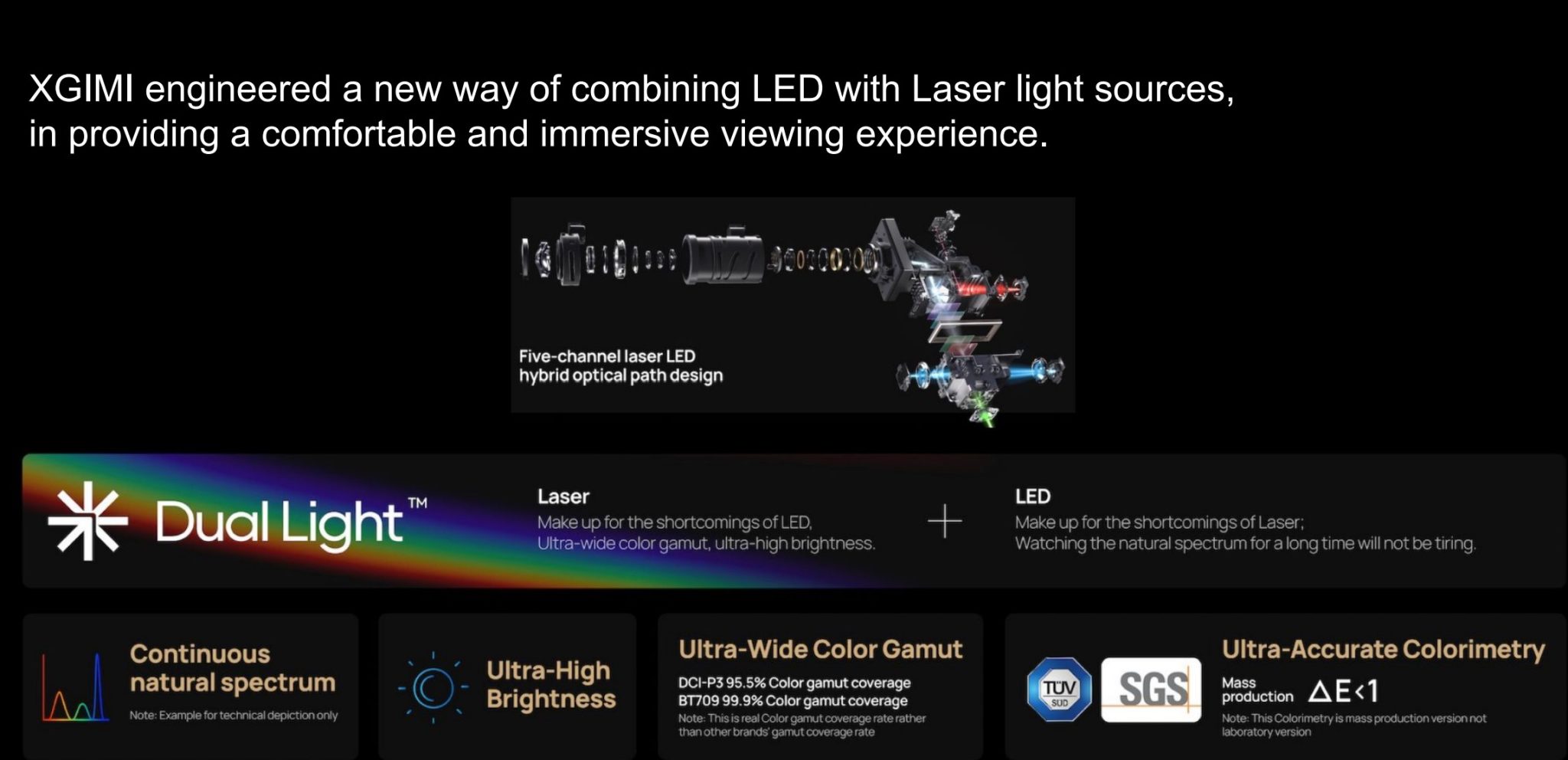 Optical unit with XGIMI Laser LED light source
Optical unit with XGIMI Laser LED light source
The first problem encountered by the designers of this system is that the LED and laser light sources are not easily compatible with each other. The first benefits from light with a very broad wavelength, while the second has a very narrow wavelength. To get around this problem, the brand's development team developed a colored LED diode that aligns with the wavelength of the laser source, as well as a special wavelength laser.
The second problem was to implement this in the company's mechanical optical system, the result being a new five-channel LED-laser hybrid optical path design (as you can see in the image below). below). This was made possible thanks to the ingenious arrangement of the position of the light source and the recombination of the optical materials. Thus the perfect combination of the two light sources could be achieved.
 Hybrid LED laser XGIMI
Hybrid LED laser XGIMI
 XGIMI Horizon Ultra and remote control
XGIMI Horizon Ultra and remote control
This all culminates in the Dual Light system found in the Horizon Ultra. Note that in comparison with the recently unveiled ALPD solution, XGIMI only uses a laser block associated with three LEDs, the Appotronics solution brings together three Red Green and Blue laser diodes with their LED equivalents.
The Body
If the Ultra shares the name “Horizon”, its shape differs from that of its predecessors. The gray cubes give way to a white/beige casing with the motorized optical protection panel which is covered with a gray fabric. Its dimensions are 10.4” (L) x 8.9” (W) x 6.7 cm (H) for a weight of 11.5 lbs.
Since we are examining the facade, the manufacturer had the good idea of ??equipping this model with an optical zoom. Until now, it was only a digital zoom and we all know that this kind of artifice negatively impacts the precision and resolution of the image. The Ultra therefore benefits from a projection ratio of 1.2:1 -1.5:1. This means that unlike the other lifestyle projectors out there, you don’t need to physically move the device further from the movie screen to make a larger image size.
With the ability to produce an image size from 40” to 200” you have a tremendous range giving you the ability to create a very large image anywhere you go.
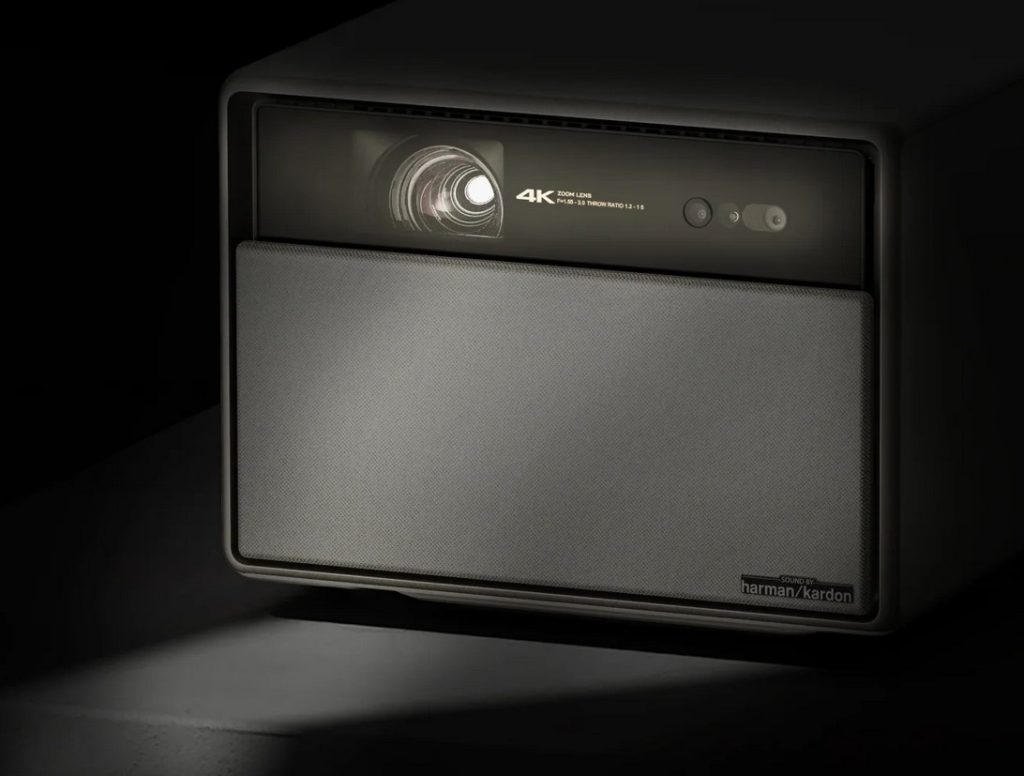 XGIMI Horizon Ultra
XGIMI Horizon Ultra
Zoom and focus are controlled electrically using the Bluetooth remote control which can also control the device by voice using Google Assistant.
 XGIMI Horizon Ultra remote control
XGIMI Horizon Ultra remote control
The Horizon Ultra is equipped with a 3D ToF module, a dynamic color adjustment module, a dynamic Iris module and an optical zoom module. In terms of image correction functions, the Ultra, thanks to its proprietary ISA 3.0 system, supports autofocus and omnidirectional automatic keystone correction.
Here are all the automated functions taken into account by the ISA 3.0 device:
- Automatic alignment with your projector screen
- Autofocus for a sharp image
- Omnidirectional electronic keystone correction
- Obstacle avoidance that shrinks the image to avoid light path blockage
- Laser dimming when it detects someone moving into the light path for eye protection
An optical iris is positioned in the light path to increase contrast.
Menus And Calibration Settings
The overall interface runs on Android TV 11.0 with a dedicated application store. A media player is available directly for audio and video files but if that isn't enough, you can always load Kodi or VLC.
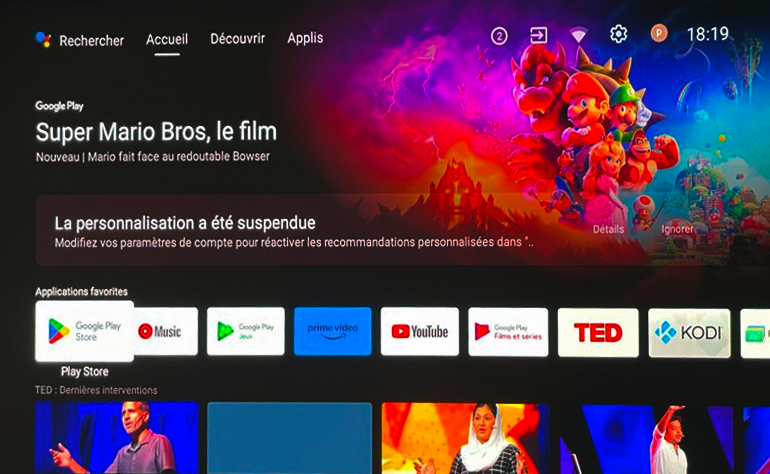 Android Menu XGIMI Horizon Ultra
Android Menu XGIMI Horizon Ultra
Picture Modes
There are 5 factory image modes and they are broken down as follows:
- Film
- Television
- Football
- Game
- Custom
Only the “Custom” mode allows access to all the adjustment parameters. The other configurations limit interventions to the activation of HDR signals or image interpolation (low, medium or high) with the exception of "Game" mode which only has a standard or boost setting.
It is also possible to have access to color modes (these are, in fact, particular settings of the gray scale which are in the following order: cinema, vivid, clear, performance, personalized and high precision of the colors. This last option should make it possible, according to the manufacturer, to achieve "deltaE differences less than 1!".
Editor's Note: But what DeltaE gaps are we talking about? The Gamut? Gray scale? Skin tones?
To calibrate the image, you have the choice between a wide (DCI-P3) or restricted (rec.709) Gamut. The gray scale can be corrected at two points “Gain” and “Offset”. The “Color Correction” submenu is a Color Management System (CMS) which allows you to intervene on the three dimensions of Gamut (hue, saturation and brightness).
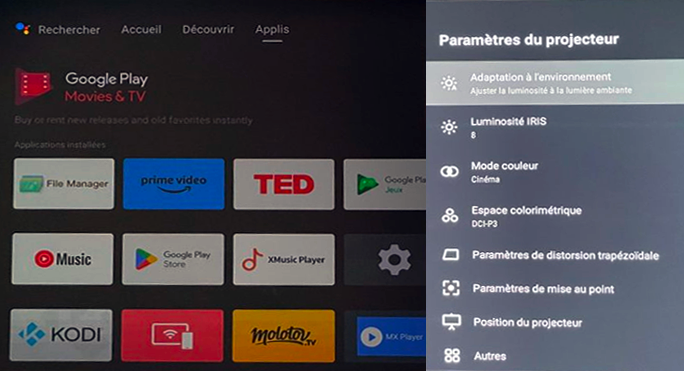 XGIMI Horizon Ultra Menu
XGIMI Horizon Ultra Menu
Three configurations dedicated to supporting dynamic metadata sources are offered: “ Bright, Dark or Custom”. HDR10/HLG static metadata are the poor relations of this device, no particular EOTF management is available. The only choice offered is HDR “on” or “off”.
For adjusting the light power, two parameters exist. An automatic mode called “dynamic contrast” and the second is that of choosing the closure of the iris on a scale from 1 (more closed) to 10 (totally open).
Technical Verdict
As a preamble to the publication of the measurements in the “technical verdict” section, I must point out that between the date of receipt of the device and the publication of the test bench, a significant update required me to redo all my measurements. The manufacturer was attentive to my feedback (as well as that of other testers) and continues to seek to improve its latest product.
Image Accuracy And Sharpness:
The XGIMI Ultra benefits from a high-quality optical unit (High Light Transmission Coated Lens) designed to reproduce a 4K image. The various analyzes of the image, thanks to my 4K measurement targets, demonstrate very good stability and uniformity on all parts of the diffusion (center, edges and angles).
 XGIMI Horizon Ultra image accuracy
XGIMI Horizon Ultra image accuracy
Despite these very good results, the manufacturer once again demonstrates its propensity to overdo it with the sharpness settings. This way of proceeding is certainly intended to attract the eye but it generates elements absent from the original image, such as split characters or double lines. I had to set the sharpness to 0 to make the unwanted effects disappear.
 Negative effects of excessive sharpness XGIMI Horizon Ultra
Negative effects of excessive sharpness XGIMI Horizon Ultra
I would like to drive home the point with the designers at XGIMI who will surely read this test after its publication. Your optical unit does the job very well without the need to overdo it with the sharpness adjustment.
Motion Handling:
Unlike the sharpness adjustment, the intervention and handling of judder by the image interpolation device remains discreet. It is available for SDR and HDR sources. I must also recognize that even without it, the problems generated by converting all incoming signals to 60hz are more faintly perceptible than on other models.
Overscan and gray border of the DMD 0.47 chip:
The inactive area of ??micro-mirrors, which is the origin of the gray border which surrounds the useful image, has a width of 2 cm. It's common with this DMD chip. What is also typical is the absence of cropping of the edges of the image by the projector's internal video processing as demonstrated by the overscan test pattern below.
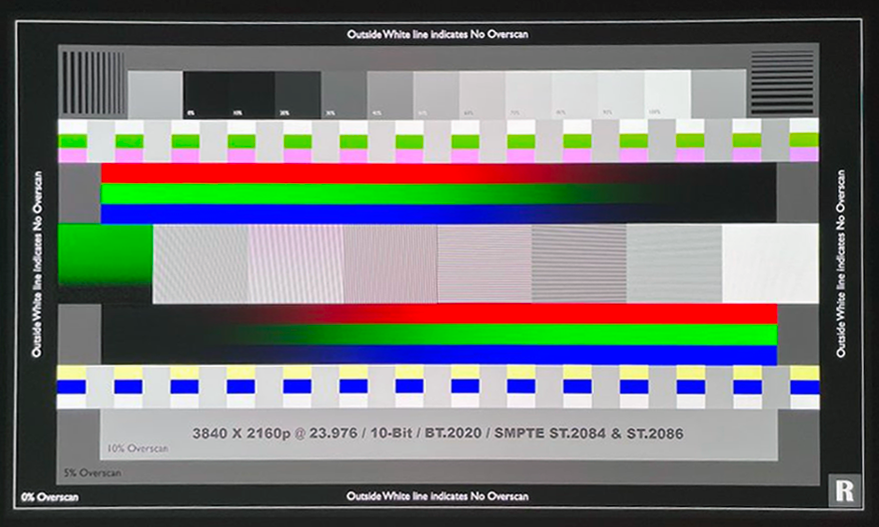 Overscan XGIMI Horizon Ultra
Overscan XGIMI Horizon Ultra
Colorimetry and Gamma:
With the Gamut DCI-P3, the color space of this XGIMI does not fully cover the digital cinema references (94.9%). It's better than lamp projectors but not as good as the triple laser models which manage to reach and exceed BT.2020 like the Hisense C1 and Formovie X5 which can achieve 110%.
 Gamut DCI-P3 XGIMI Horizon Ultra
Gamut DCI-P3 XGIMI Horizon Ultra
In this analysis segment, the results are closer to an LED projector rather than to a Laser projector.
The manufacturer highlights colorimetric fidelity with a deltaE of 1 right out of the box. What bothers me with this kind of advertising argument is that we don't know what deltaE we're talking about and with what references (Gamut, gray scale, etc.).
I did my SDR and HDR measurements and didn't find any results that got deltaE less than 1 without calibration. However, it must still be said that the colors are rather well adjusted out of the box in SDR but you have to know with what parameters.
I got very good results with firmware version 1 with a color temperature of 6553K, a deltaE deviation of 2.09 and a slightly low Gamma at 2.14 after enabling the "high color accuracy" option. ". Unfortunately, the transition to V2 changed this situation and I was unable to reproduce this ideal result. It is highlighted in blue in the summary table.
XGIMI Horizon Ultra (V2) - Contrast Brightness Measurement Table
Favorite |
Mode |
Lumens |
Colors / ΔE |
Gama |
Native Contrast |
Dynamic Contrast |
|
Film |
|
6500K / 05,68 |
2,16 |
459 : 1 |
689 : 1 |
|
Television |
|
6390K / 06,61 |
2,27 |
454 : 1 |
697 : 1 |
|
Football |
|
6454K / 05,26 |
2,13 |
454 : 1 |
697 : 1 |
|
Game |
|
6445K / 05,03 |
2,14 |
454 : 1 |
697 : 1 |
|
High Color Accuracy |
|
6553K / 02,09 |
2,14 |
454 : 1 |
697 : 1 |
|
Caliber |
|
6459K / 00,60 |
2,34 |
432 : 1 |
554 : 1 |
At 1080p SDR |
Recommended screen base for 16 fL |
3m90 |
|
|
|
ANSI : 104.1 |
At 4K HDR |
Recommended screen base for 26 fL |
3m07 |
|
|
|
|

With the second version of the firmware and by positioning the color mode in the “ Film ” position (the fairest), all the image modes have the same color temperature, the same light power and the same contrast level (see the summary table below -above). If the gray scale is often close to 6500K, the deltaE differences are around 5/6. It's not perfect but with these results out of the box, it is possible to do without further calibration.
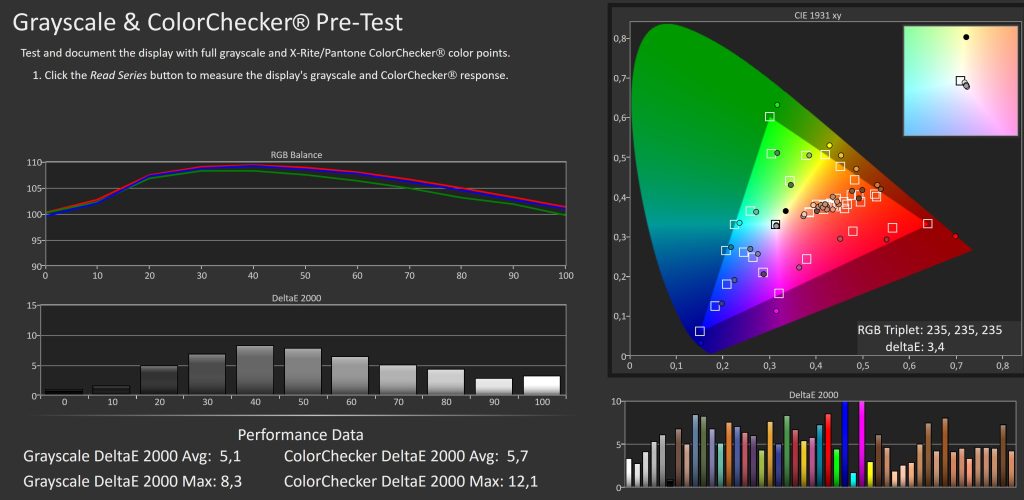 Pre-Calibration, XGIMI Ultra (Second Firmware)
Pre-Calibration, XGIMI Ultra (Second Firmware)
I nevertheless pushed the Ultra to its limits by calibrating it with the Calman software in professional version, my Klein 10A colorimeter and a profile generated by my Jeti 1501 Hi Res spectrophotometer. I managed to lower the deltaE differences below 1 (well done Grégory and XGIMI!) with a Gamma close to the target of 2.4 (2.34).
 Post-Calibration, XGIMI Ultra (Second Firmware)
Post-Calibration, XGIMI Ultra (Second Firmware)
This projector is therefore perfect for all audiences, those who want to be able to use the device without spending hours in settings and purists who are looking for a PVA level calibration (D65, Gamma 2.2 or 2.4 depending on the room and deltaE difference less than 2).
HDR Management:
With the first firmware, mapping problems appeared from 600 nits, with the second the projector positions its EOTF level correctly for encodings from 600 to 1000 nits but clipping begins to appear at 2000 nits.
Please note, dynamic contrast must be activated to achieve these results.
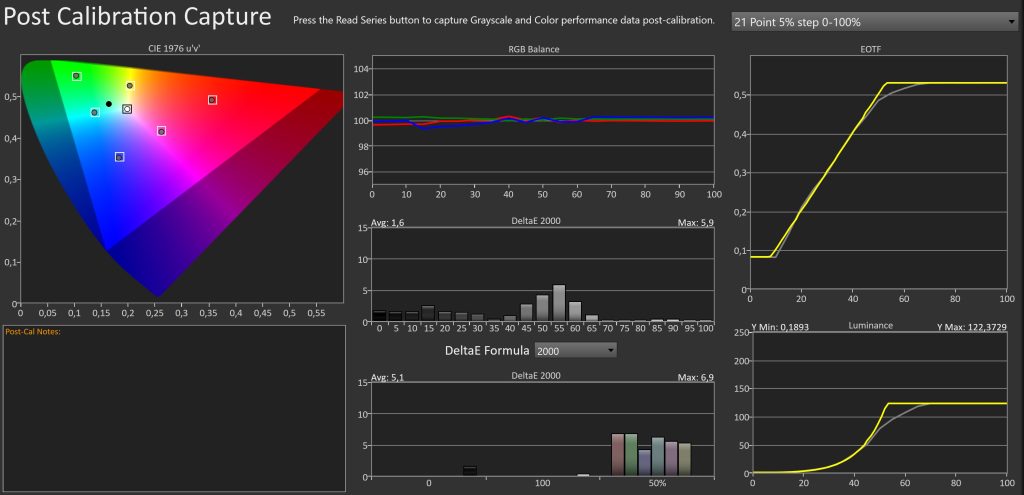 XGIMI Ultra HDR Calibration
XGIMI Ultra HDR Calibration
As the Ultra does not have dynamic management of HDR10 metadata, a little calibration is necessary to correctly position the EOTF level. I no longer communicate my post-calibration values ??but in this case a little extra contrast will help improve the situation.
Dolby Vision Management:
The Ultra 's support for Dolby Vision signals is good news for the user. In fact, source and diffuser work together to provide the right level of brightness and contrast. This automatic management promised by dynamic metadata support is however contradicted by the presence of three operating modes “Dark, Bright and personalized”. In my configuration, the "Dark" selection (which despite its name is the brightest) is the one that appears to be the most user friendly.
It is possible to intervene on some of the parameters including that of colorimetry in the personalized mode.
Contrast:
If the manufacturer easily communicates on the light power, no figure is given for the contrast. After my first measurements, I quickly understood why. The Ultra 's native contrast is close to that of the LED-only versions ( Horizon and Horizon Pro ). With 432:1 post calibration, this is a very low value. The dynamic contrast and the iris will not be of much help. The Ansi contrast at 104:1 finally convinces me that the Ultra, despite its innovative light source, will not do better than its predecessors in this essential area of home cinema image.
 XGIMI Ultra HDR Calibration
XGIMI Ultra HDR Calibration
With a few little tricks it is possible to slightly increase the readings (activation of room brightness detection, lowering of the iris level) but this is not a native value and at most I cap at 695:1 ( dynamic).
Brightness:
The maximum light power reaches 2190 lumens with usable colors but after calibration, I manage to maintain an excellent 1417 lumens, which allows it to broadcast an HDR image of 120” in 16:9 format while maintaining a luminance of 26 fL and up to 150” in SDR with 16 fL. It’s still got plenty of lumens to spare!
Laser Speckle:
The choice of the hybrid Laser/LED architecture proves relevant in the fight against laser speckle effects (hundreds of small dots present in the brightest parts of the image). The Horizon Ultra is absolutely not affected by this visual defect.
Input Lag:
With game mode, whether with the boost or standard option, the display delay remains limited to 35.1 ms with a UHD signal at 60hz. This is below 50 ms, which allows the Ultra to fit under the “Gaming projector” qualification. It has a solidly low latency but falls short of other, more dedicated 4K video game projectors.
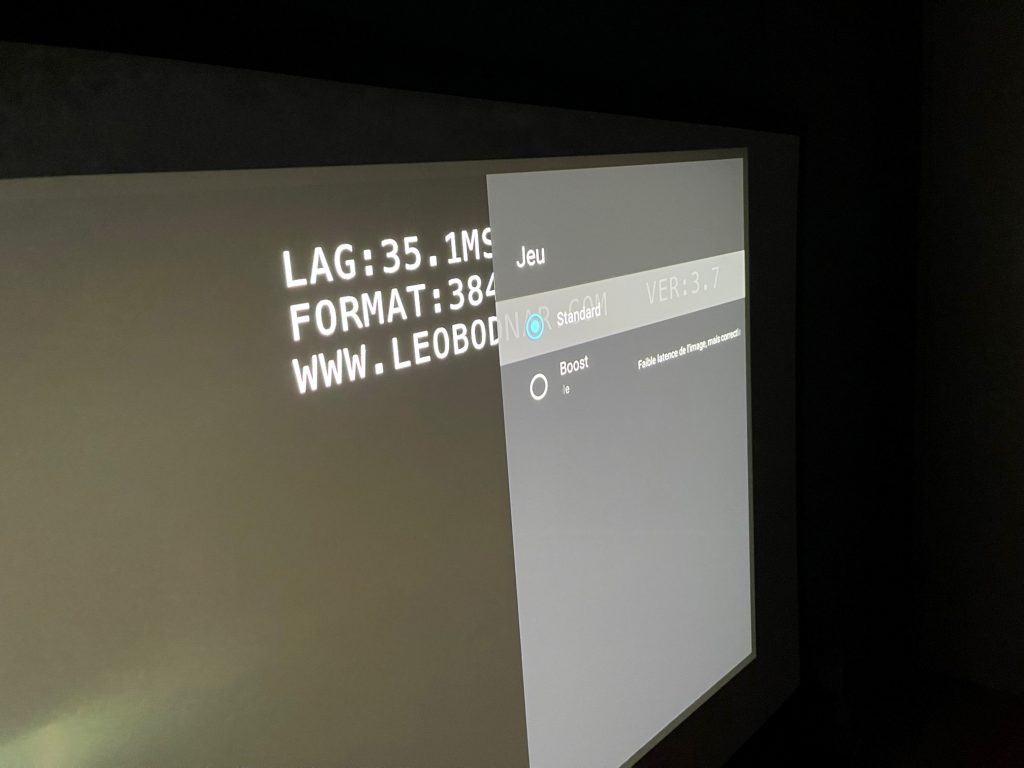 Input lag Horizon Ultra standard mode
Input lag Horizon Ultra standard mode
Uniformity:
Of the 15 image analysis sectors, the deltaE differences with the central reference are limited to 4. This measurement confirms the analysis of image precision already carried out.
Built-In Speakers:
The brand continues to trust Harman Kardon for the sound equipment of its high-end devices and it is an excellent choice. The two 2x12W speakers ensure reproduction of the soundstage of your films and series with great finesse (we just regret the absence of a subwoofer). The Ultra can also be used as a Bluetooth speaker (this is its use at the time of writing this test) with or without a projected image.
Operating Noise:
The brand's engineers have paid particular attention to the discretion of their new offspring. After measuring the ambient noise present in my test room (33.9 dB), I noted almost similar levels between the iris positioned at 1 and 10, i.e. 34.3 dB and 34.4 dB respectively. Suffice it to say that there is very little variation between the projector off and on. The Ultra can therefore take its place in the category of the most discreet front diffusers.
 Residual room noise
Residual room noise
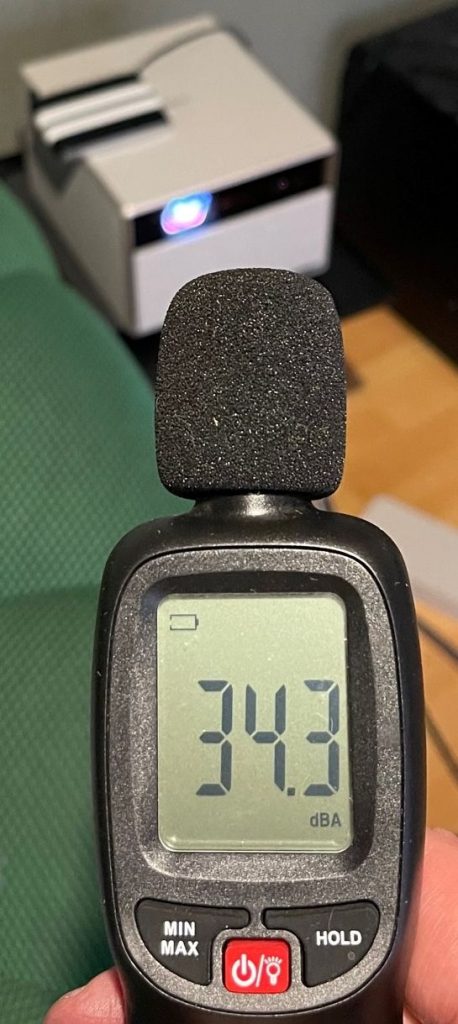 Active Iris operating noise
Active Iris operating noise
 Noise level
Noise level
Power consumption :
The analysis of the electricity consumption revealed some surprises to me. By positioning the Ultra with the iris at 10 (therefore the brightest), the electricity requirements rise to 129.1W. By changing the iris to 1, the consumption is increased to 199.1W when one would expect the opposite. I have forwarded these results to XGIMI and am awaiting their response on this matter.
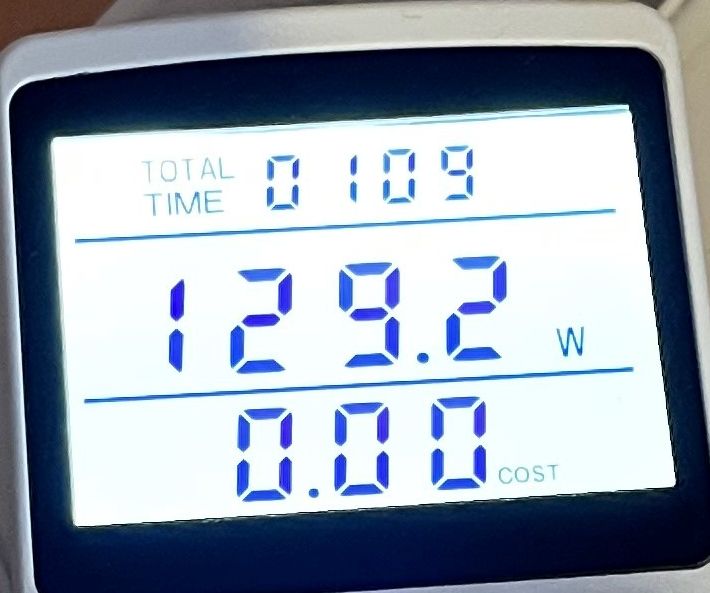 Power consumption Iris 10
Power consumption Iris 10
 Power consumption Iris 1
Power consumption Iris 1
Subjective Opinion
The XGIMI Ultra could be used as a reference projector due to its color accuracy. If you want to be able to watch a film or series with a faithful reproduction of the instructions given by the director to his director of photography, well, you will find in the Horizon Ultra a soldier dedicated to the cause of colorimetric accuracy.

Whether in SDR, HDR or Dolby Vision, the precision of the image is astonishing for a device of this size. The care taken by the manufacturer (who designs and manufactures its models) in its optical unit is reflected in the image.
Fluidity is also a criterion of visual comfort, associated with the total absence of laser speckle and a beautiful uniformity. The image of the XGIMI Ultra is never tiring.
 Dolby Vision XGIMI Horizon Ultra
Dolby Vision XGIMI Horizon Ultra
I must also point out that the management of Dolby Vision sources is particularly efficient, especially with the “Dark” selection.
There remains the subject of dynamics. The definition of this criterion is the relationship between contrast and brightness. For this to work, the two must be balanced. In the case of Ultra, it is the light power that dominates. This particularity will allow this model to perform for all daytime scenes, television shows or animated films but when the dark passages arrive, like the scenes in the holds of the Last Voyage of the Demeter, well, no matter how much you use the remote control, the iris or the dynamic contrast, the latest XGIMI will no longer have anything “Ultra”.
Conclusion
The announcements of the development and launch of this hybrid LED/Laser solution have generated a lot of hope among home cinema enthusiasts. Indeed, one of the few weak points that remained with XGIMI in a rather flattering general picture was the improvement in contrast. Alas and triple alas, the expected qualitative boost is not there. The Ultra is not the only one to present this characteristic, most current 0.47 DLP projectors with classic focal length, whether lamp, LED, laser or now both LED/Laser, suffer from this weakness.
I remind you, contrast is what the human eye perceives first in an image, which is why this parameter is so important. That said, the Ultra has some strong points and in this conclusion I wanted to particularly highlight the work done upstream (in the factory) on the colors to offer the user a rendering that does not require going through the calibration box. It's rare enough for it not to be highlighted and this characteristic added to the precision, fluidity and brightness lead me to deliver a mondoprojos.fr Silver Award to the XGIMI Ultra. It aims to encourage the brand in its development efforts and to ensure that in the future the same care is taken with colors,

Silver Award Mondoprojos
I appreciated:
- Optical and motorized zoom
- The luminosity
- Operating discretion
- The integrated sound system
- Smart TV functions
- Sharpness
- The fluidity
- Colorimetry
- Dolby Vision support
BenQ X3100i Lifestyle Gaming Projector Review
Thinking about a new lifestyle projector? Read our review of the BenQ X3100i that covers everything you need to know about this on the go device from the experts in projection. We break down this new...
Keep Reading
The Best All-In-One 4K Projector Shootout For 2023
Which lifestyle projector is best? We put the top options head to head and assembled a team of expert judges to answer that question. Find out which all-in-one portable projector they think is #1 and...
Keep Reading
XGIMI Horizon Ultra Projector Review
Find everything you need to know about the XGIMI Horizon Ultra in this expert projector review. We break down this new lifestyle projector and give you our thoughts and ratings so you can decide if...
Keep Reading